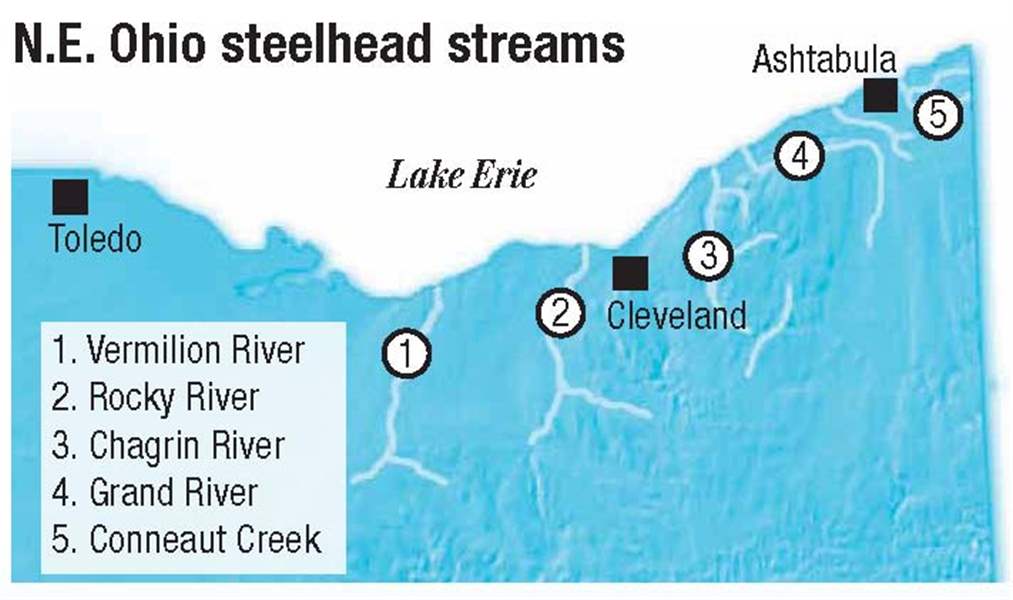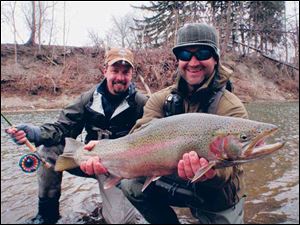
TOLEDO MAGAZINE: OUTDOORS
The making of a steelhead
Hatchery provides raw material for dynamic fishery
10/28/2012

Kelly Gilmore of Mentor, Ohio, left, and Will Waldrip fo Austin, Texas, with a trophy steelhead caught on the Rockey River.
CASTALIA — Ohio's powerful trophy steelhead start their lives in the Buckeye State in rather humble fashion.
They ride in coolers from their birthplace in Michigan, packed in plastic bags by the tens of thousands. At a state-of-the-art hatchery here, they are transferred to plain, white buckets and disinfected before they are allowed in the building.
After a year of meticulous nurturing, the steelhead are released into five northeast Ohio streams when they are about 6-8 inches in length. Following another year or two of feeding and growing, the fish migrate into Lake Erie in late spring, seeking cooler water, and there they grow to reach 25 inches long and push six pounds.
When the steelhead have made this round trip a few times — spending fall, winter, and spring in the rivers and the warmer months in the lake — they assume blockbuster size, with these colorful combatants clearing 30 inches and 10 pounds.
The Castalia State Fish Hatchery that shepherds the first phase of this process is a virtual steelhead factory. The facility, which completed a $7 million renovation earlier this year, produces 400,000 steelhead annually, thanks to its healthy supply of 52-degree water furnished by the many blue hole aquifers in the area.

That wealth of cold water provides the ideal nursery habitat for the rainbow trout and steelhead raised here. While the rainbow are used primarily to stock ponds and small lakes for youth fishing events, the steelhead are planted in the Rocky, Chagrin, Grand, and Vermilion rivers and Conneaut Creek, where they maintain one of the finest steelhead fisheries in the country.
"The value of that hatchery and its ability to produce steelhead and provide this kind of opportunity here in Ohio — it's priceless," said Owen Murphy, who operates Ohio Steelhead Drifters guide service in the Cleveland area.
"The economic impact is huge. You have fishermen from all over coming to Ohio in the dead of winter because of the quality steelhead fishing we have. And it's not all off in the wilderness somewhere — it's as close as15 minutes from downtown Cleveland."
Castalia is the only hatchery in the state to produce steelhead — a rainbow trout that migrates into the lake, then returns to the river to spawn. Steelhead are usually a bright silver with a pronounced pink band, with the males developing a threatening looking hooked jaw during the spawning period.
The steelhead raised at Castalia are the Little Manistee River wild strain, and Ohio trades catfish with Michigan to acquire more than a half million steelhead eggs each spring.
Once the steelhead arrive at the hatchery early in the year, they are under the care of Andy Jarrett, the superintendent of the operation. Mr. Jarrett pampers the steelhead, from the fertilized egg stage until the day they are loaded into trucks and transported to the release sites.

"Steelhead are very density dependent, so we keep moving them around inside the facility until we run out of room," he said. "At one point in the spring, every tank here is filled with steelhead."
Around the end of the summer, the fish reach two or three inches in length and are moved into the long, covered runways where they can spread out and continue to grow.
Before the renovation and the addition of new buildings at the hatchery, Ohio had to purchase fingerlings from Michigan in order to reach the production quota.
"Now, we have about four times the space that we did before," Mr. Jarrett said. "We haven't changed the production numbers, but just made the quality much better. In the past, sometimes we struggled to reach that seven-to-nine inch size."
A healthy fish for stocking will maintain the prime steelhead fishery in Ohio's streams, Mr. Murphy said.
"We have good numbers of fish in these rivers, and as word spreads, I'm seeing younger fishermen highly interested in fishing for steelhead," he said. "Because of our very effective stocking program, Ohio has outstanding steelhead fishing, and there are still a lot of people just hearing about it."
Contact Blade outdoors editor Matt Markey at: mmarkey@theblade.com or 419-724-6068.